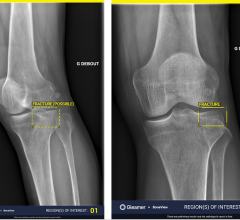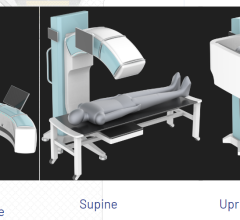
The FDR AQRO is a compact mobile digital X-ray system.
As the largest provider of inpatient and outpatient services in New Jersey, Hackensack Meridian Health Hackensack University Medical Center caters to a diverse patient population.
The 775-bed, nonprofit teaching and research hospital tends to everyone from the elderly to newborn infants. But as any clinician will tell you, patient needs vary not only according to their disease states, but according to their age or life stage, as well.
Topping the Garden State’s rankings, the hospital is constantly bringing in new equipment to help its staff provide the absolute best patient care possible. One recent example of that ever-present drive to deliver high-quality care is the facility’s purchase and installation of a new FDR AQRO mini-digital X-ray system and five FDR Go digital radiography (DR) portable X-ray systems, all from Fujifilm.
“We set out to find a vendor that produces the lowest possible dose but also high quality images,” said Michael Horton, MHA, administrative director of clinical services, Hackensack University Medical Center. “We also wanted to make sure we were buying systems that are fiscally responsible. Our goal was to purchase equipment that is reliable and high quality, yet at an affordable price point.”
Minimizing Dose a Top Priority
One of the primary reasons Hackensack University Medical Center chose Fujifilm’s DR solutions was the role they could play in helping minimize ionizing radiation across the board. Hospital employees all follow Image Gently and the ALARA (as low as reasonably achievable) principle, and it’s something they take very seriously.
Early feedback from physicians showed that the FDR AQRO delivered sharp, clear images at a low dose. That’s because the FDR AQRO system combines the high sensitivity of Fujifilm’s FDR D-EVO II detectors and its refined image processing advancements to generate high resolution images with low patient dose.
“Within the imaging community, we’re all working to achieve the highest possible resolution with the lowest possible radiation dose,” Horton said.
Smarter Workflow, Better Images
What’s more, the system’s Dynamic Visualization II image processing adjusts image quality throughout the entire exposure field based on intelligent feature and thickness recognition.
Michael McGuire, M.D., a pediatric radiologist at the hospital notes that the FDR AQRO helps clinicians better see very small IV catheters — 0.3 millimeters in diameter — in premature babies in the NICU. The result means fewer imaging exams and a lot less radiation exposure for these most vulnerable patients.
“With FDR AQRO, we were able to decrease dose technique compared to what we did with the former CR system, and still acquire a super high-quality image with really good spatial resolution and not a lot of noise and we can see the catheters,” said McGuire.
According to McGuire, the FDR AQRO has “drastically reduced” dose for both NICU babies as well as children throughout the pediatric unit.
Faster Scans, Better Outcomes
Speedier scans are perhaps one of the biggest benefits of the FDR AQRO at Hackensack University Medical Center.
“The imaging time with FDR AQRO is much quicker. With CR, we would have the extra step and wait to scan each image and the process would take about three minutes,” said Caroline Nieves, RT, chief radiologic technologist at the hospital. “Now the time it takes to acquire an image has been cut less than half. We can upload an image quickly and send it to the PACS.”
Previously with CR, techs would shoot the image, take the cassette, run downstairs to put it through a multi loader, and scan it into the system while NICU doctors stood by waiting for the images to appear at their PACS workstation.
“[FDR] AQRO has helped workflow for umbilical IV lines and tubes because the doctors can see it right away,” said McGuire. “For those physicians, workflow has greatly improved because they can adjust the lines right away without having to wait for the CR films to load into PACS.”
Speedier workflow means better care and improved outcomes for neonatal, pediatric and adult patients.
A Versatile Solution
The FDR AQRO has proven to be a versatile solution that is serving the women’s hospital as well. Technologists and clinicians alike feel the user-friendly, patient-friendly system goes the extra mile.
“It even works well on bariatric patients, where you might think the image quality would not be diagnostic standards,” said Caroline Nieves, RT, chief radiologic technologist, Hackensack University Medical Center. “We are able to image obese patients using Virtual Grid, which saves on dose and delivers a better image. The image is just as good as if you had a physical grid.”
Simply put, Fujifilm’s DR solutions are making a positive difference for Hackensack University Medical Center’s clinicians and technologists — and for patients of all ages.
For more information: www.fujimed.com



 December 10, 2025
December 10, 2025 








